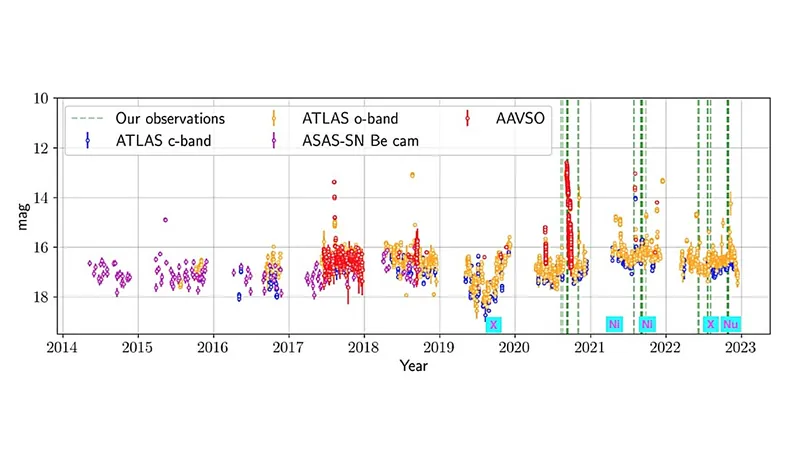
Astronomers Unravel the Mysteries of a Rapidly-Spinning Intermediate Polar Star
2024-10-07
Author: Arjun
A team of astronomers from Columbia University and their collaborators has made significant breakthroughs in understanding a curious astronomical object known as CTCV J2056-3014. This system, classified as an intermediate polar (IP), hosts one of the fastest-spinning white dwarfs identified to date. Their findings, published on September 26, 2023, on the pre-print server arXiv, promise to deepen our understanding of this intriguing celestial body.
Understanding Intermediate Polars
Intermediate polars are fascinating binary star systems that include a white dwarf drawing material from a companion star. These systems are characterized by their irregular brightness spikes, commonly referred to as outbursts. In contrast to traditional cataclysmic variables (CVs), where the white dwarf exhibits a more stable magnetic field, intermediate polars possess a moderately strong magnetic field. This unique feature results in asynchronous spinning of the white dwarf with the system's orbital period.
CTCV J2056-3014: A Unique System
CTCV J2056-3014, located approximately 853 light years from Earth, was first detected in 2010 and is now recognized as one of the few known fast-spinning cataclysmic variables (FSCVs), boasting a spin period of just 29.6 seconds. The system’s orbital period, measured at around 1.76 hours, adds to its remarkable characteristics.
Previous Observations and Notable Findings
Previous studies have shown that CTCV J2056-3014 exhibits faint X-ray emissions and displays signs of dwarf novae and superoutbursts in optical observations, indicating that it shares traits with WZ Sge-type cataclysmic variables. These systems are known for their sporadic outbursts, suggesting variable mass accretion processes.
To delve deeper into the mystery of CTCV J2056-3014, the research team, led by Ciro Salcedo from Columbia University, harnessed the power of several advanced X-ray observatories, including ESA's XMM-Newton, NASA's NuSTAR, and the Neutron star Interior Composition Explorer (NICER) stationed on the International Space Station. Their observations conducted between 2019 and 2022 revealed a unique pulsed profile, characterized by a single broad peak with roughly 25 percent modulation.
X-ray Flux and Optical Flare
Notably, a dramatic four-fold increase in X-ray flux was detected, coinciding with an optical flare in November 2022. These variations not only emphasize the dynamic nature of this system but also suggest significant changes in its accretion processes.
Classification Challenges and Future Research Directions
The study indicates that the properties of CTCV J2056-3014, including low plasma temperatures and a lack of significant X-ray absorption at lower energies, align with those commonly observed in other fast-spinning cataclysmic variables. However, uncertainties remain regarding its true classification, particularly due to indications of accretion-powered emissions and weak iron spectral lines in its lower energy states.
To clarify the classification of CTCV J2056-3014 and further explore its optical properties, the team is preparing a follow-up research paper. In addition, they successfully estimated the white dwarf's mass to be between 0.7 and 1.0 solar masses, which is consistent with other known cataclysmic variable systems.
Continuing the Journey of Discovery
As astronomers continue studying CTCV J2056-3014 and other similar systems, the intricate dance between white dwarfs and their companion stars continues to reveal the complexities of binary star evolution—a captivating frontier in the field of astrophysics. Stay tuned for more groundbreaking discoveries in the universe!


 Brasil (PT)
Brasil (PT)
 Canada (EN)
Canada (EN)
 Chile (ES)
Chile (ES)
 España (ES)
España (ES)
 France (FR)
France (FR)
 Hong Kong (EN)
Hong Kong (EN)
 Italia (IT)
Italia (IT)
 日本 (JA)
日本 (JA)
 Magyarország (HU)
Magyarország (HU)
 Norge (NO)
Norge (NO)
 Polska (PL)
Polska (PL)
 Schweiz (DE)
Schweiz (DE)
 Singapore (EN)
Singapore (EN)
 Sverige (SV)
Sverige (SV)
 Suomi (FI)
Suomi (FI)
 Türkiye (TR)
Türkiye (TR)